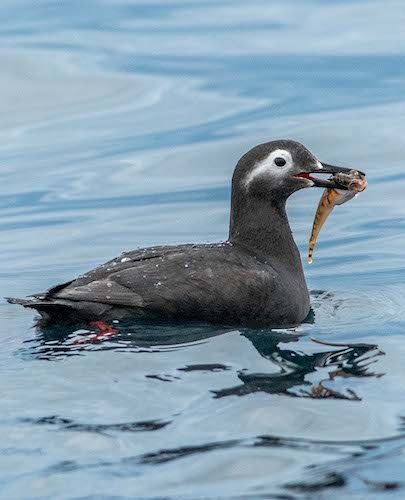Kamchatka Krai

Birding Kamchatka
The Kamchatka Peninsular consists of the ‘Oblast’ of Kamchatka and the Autonomous ‘Okrog’ of Koryakia.
Kamchatsky peninsula is the land of volcanoes and geysers. Most of the region is occupied by light Erman’s birch and larch forests. Mountainsides are covered with cedar elfin woods and lichens. It’s possible to find high-grass meadows. The western part of peninsula is typical tundra. Along the entire region runs the Sredinny mountain ridge. Snow occupies its peaks throughout the year. Its sea-shore serves as a breeding site for birds, which adapt themselves to hard conditions, such as Pelagic Cormorant and Steller’s Sea Eagle. Rocky banks and numerous islands are rookeries, where it’s possible to find Ancient Auks, Puffins, Sooty Guillemots and other interesting species.
-
Komandorskie Islands
Satellite ViewThis site includes four large islands, more than 60 small islands and the water adjacent to them. Large islands, such as Medny and Beringa, are hilly with lichens tundra on the top. Along rivers and streams there are grasslands and bushes. Small islands have rookeries. You can see here such birds as Aleutian Tern, Crested Auk, Whiskered Auk, Puffin, Guillemot, Common Guillemot, Leach’s Petrel, Fork-tailed Petrel, Pelagic Cormorant, Red-faced Cormorant and Kittiwake. -
Kronotsky Reserve
WebsiteSatellite ViewThe most attractive sites for birdwatcher are the rookeries. The latest investigations has discovered 69 colonies of sea birds, which include nine species: Slaty-Backed Gull, Puffin, Pelagic Cormorant, Pigeon Guillemot, Horned Puffin, Common Guillemot, Thick-billed Guillemot, Glaucous Gull and Fulmar. The northern part of the reserve is tundra zone. Not only sea birds live here, but also Steller’s Sea Eagles, Peregrines, Merlins, Tundra Grouse and Siberian Ground-linnet Finches make their nests on the rocks. Moreover, it should be noted, that most of the passerines on the peninsula are endemic races. The most common species of the mountain forests and bushes are Rustic Bunting, Indian Tree Pipit, Arctic Warbler, Ruby-throat and Scarlet Grosbeak. It’s possible here to also see Chinese Greenfinch and special Pallid Thrush. Along the rivers you can find Harlequin Duck, Golden-eye, Red-breasted Merganser, Goosander, Scaup, Siberian Gray-rumped Sandpiper, White & Grey Wagtails.
-
Olga Batova
Ecological Travel Center - Moscow | info@ecotravel.ru
http://www.ecotravel.ru
-
Marine Important Bird Areas of the Russian Far East
| By Yu B Artiukhin | Avgust Borg | 2016 | Paperback | 135 pages, colour photos, colour maps, colour tables | ISBN: 9785990759220 Buy this book from NHBS.com
-
NR Kronotsky
InformationSatellite ViewKronotsky is mainly accessible only to scientists, plus approximately 3,000 tourists annually who pay a fee equivalent to US$700 to travel by helicopter for a single day's visit. It is part of Volcanoes of Kamchatka, a UNESCO World Heritage Site. The nature reserve boasts over 800 brown bears, some of the largest in the world that can grow to over 540 kg (1,200 pounds). The 800-plus population make it Eurasia's largest protected brown bear population. Bears in the Kronotsky reserve often encounter each other at salmon streams in the park where they can socialize freely with each other.
-
Ecological Travel Centre - Kamchatka Birding Tour
Tour OperatorKamchatka and Commander's islands, situated on the north-east from the peninsula in the Pacific, are recognised as one of the most exciting regions of Russia. Its nature and wildlife are astonishing. Here, over 390 bird species are registered, around 800 plant species and over 200 seaweeds species. There are approximately 400 fish species in the seas of the region
-
2014 [07 July] - Robert Ulph
Report...A lot of the birds around Petropavlovsk are familiar to UK birders with Great and Lesser Spotted Woodpeckers, Black-headed Gulls and a Reed Bunting. But harder searching, particularly in the woods, reveals the more interesting ones such as a Siberian Rubythroat, Rustic Buntings, Pechora Pipits and what I think was a Dark-sided Flycatcher (see photo). Also lots of Red-breasted/Taiga Flycatchers and Arctic Warblers.... -
2016 [06 June] - Kristian Ståhl - 1 ( 45 ) Kamchatka, Commander Islands, Kuril Islands and Sachalin Island
PDF ReportRussian Far East! This is undoubtedly one of the most spectacular and dramatic parts on our planet. The landscape is the result from the Pacific plate subducting under the North American Plate, creating volcanic and geothermal activity. -
2016 [06 June] - Lisle Gwynn - Russia's Ring of Fire
PDF Report...Even before we’d stepped foot on the ship we were blown away by Kamchatka with the mythical Black-billed Capercaillie giving walk-away views, and a superb supporting cast of Siberian breeders like Eye-browed Thrush, Siberian Rubythroat and Kamchatka Leaf Warbler.... -
2016 [06 June] - Lisle Gwynn - Sea of Okhotsk
PDF Report... Our first stop was at Piltun Bay where we cruisedalongside Gray Whales and bobbed below flocks of Aleutian Terns, whilst in the Shantar Archipelago wefaced thick ice that held hundreds of ‘Arctic seals’ like Ringed, Largha, Bearded and the most beautiful of allpinnipeds, and a Russian Far East speciality, Ribbon Seal. We also enjoyed watching Steller’s Sea Eagleshunting fish in their icy homeland... -
2019 [06 June] - Graham Talbot - Kamchatka, Commander Islands, Kuril Islands and Sakhalin
PDF ReportI decided it was time for a change. I have been to plenty of jungles, hiked enough mountains and seen plenty of Pacific islands so why not a complete change and explore the coast of East Asia and hopefully see some incredible alcids a few Whales and some stunning scenery.

